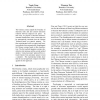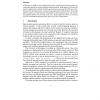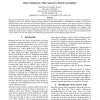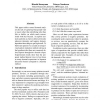ACL
2012
11 years 11 months ago
2012
The Chinese comma signals the boundary of discourse units and also anchors discourse relations between adjacent text spans. In this work, we propose a discourse structureoriented ...
ACL
2011
13 years 1 months ago
2011
Community-based knowledge forums, such as Wikipedia, are susceptible to vandalism, i.e., ill-intentioned contributions that are detrimental to the quality of collective intelligen...
ACL
2011
13 years 1 months ago
2011
Standard algorithms for template-based information extraction (IE) require predefined template schemas, and often labeled data, to learn to extract their slot fillers (e.g., an ...
CORR
2000
Springer
13 years 9 months ago
2000
Springer
A SNoW based learning approach to shallow parsing tasks is presented and studied experimentally. The approach learns to identify syntactic patterns by combining simple predictors ...
CLIN
2004
13 years 10 months ago
2004
In Jijkoun et al. [2004] we showed that off-line answer extraction using syntactic patterns is a successful method for answering English factoid questions. In this paper I will di...
LREC
2010
13 years 10 months ago
2010
Most question-answering systems contain a classifier module which determines a question category, based on which each question is assigned an answer type. However, setting up synt...
COLING
2008
13 years 10 months ago
2008
This paper tackles textual demand analysis, the task of capturing what people want or need, rather than identifying what they like or dislike, on which much conventional work has ...
ICECCS
2002
IEEE
14 years 2 months ago
2002
IEEE
Although program faults are widely studied, there are many aspects of faults that we still do not understand, particularly about OO software. In addition to the simple fact that o...




